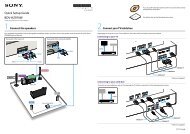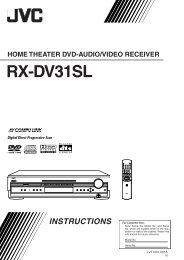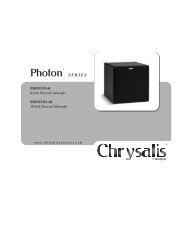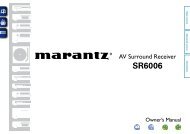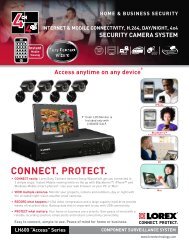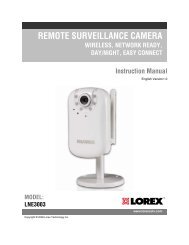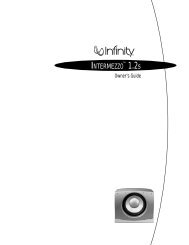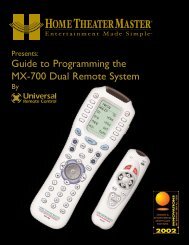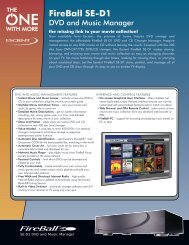Leica Sport Optics - One Call
Leica Sport Optics - One Call
Leica Sport Optics - One Call
You also want an ePaper? Increase the reach of your titles
YUMPU automatically turns print PDFs into web optimized ePapers that Google loves.
Glossary<br />
ADC (Automatic Diopter Compensation) ADC (Automatic Diopter<br />
Compensation) is the eminent innovation in Duovid binoculars. ADC maintains<br />
the original diopter setting when you change the magnification (from<br />
8 x to 12 x, or from 10 x to 15 x as the case may be).<br />
Automatic Diopter Compensation ADC<br />
Multifunction centrer drive The combination knob for the <strong>Leica</strong><br />
center drive feature performs two important functions : diopter compensation<br />
and focusing. Because of its size, it is always easy to use<br />
as a focusing wheel and it provides ergonomic handling and a steady<br />
observation. The large diopter scale allows quick and convenient<br />
setting of your personal diopter value.<br />
quick initial focusing<br />
fine focusing<br />
Removable, sliding eyecups with two click stops A newly designed<br />
rotating sliding eyecup is used on binocular models Duovid<br />
50 and 42, Ultravid 50, 42 and 32 and Geovid. It can easily be<br />
removed for cleaning at any time and it has two click stops with<br />
which different eye relief distances (AP positions) can be set individually<br />
(with eyeglasses = retracted ; without eyeglasses = pulled<br />
out). With its gently cushioning rubber element it guarantees long,<br />
relaxed observation and for eyeglass wearers it provides secure<br />
positioning without damaging the eyeglasses. The remaining <strong>Leica</strong><br />
binoculars are equipped with sliding eyecups that guarantee an<br />
optimal eye relief.<br />
Televid dual focusing The dual focusing device<br />
patented by <strong>Leica</strong> is incorporated in <strong>Leica</strong> spotting<br />
scopes. Two separate focusing drums enable the<br />
observer to perform a quick initial focusing followed<br />
by an accurate fine focusing to obtain an image<br />
that is always perfectly sharp.<br />
LED displays in rangefinders The actively glowing LED displays in Rangemaster-, Pinmaster- and Geovid models employ a<br />
sensor that automatically tailors their intensity to the prevailing ambient light at all times. This feature assures perfect legibility in<br />
all light conditions and it especially prevents eye glare during nighttime observation.<br />
<strong>Leica</strong> rangefinder technology – with a press of the button<br />
<strong>Leica</strong> rangefinders distinguish themselves primarily by the<br />
fact that they can be operated intuitively, by the excellent<br />
legibility of their LED displays and by their bright optics. Pressing<br />
the measuring button just once switches the instrument<br />
on, the target sight appears in the display and the object can<br />
now be addressed. Pressing the button a second time displays<br />
the measured distance. By keeping the button pressed,<br />
the instrument automatically switches to a scan mode, which<br />
is indicated by a blinking display. The instrument now provides<br />
continually updated measurement values. The scan mode is<br />
especially helpful for the perfect measurement of distances<br />
to small or rapidly moving targets.<br />
The measurement of distances is based on an eye-safe light<br />
pulse that is reflected by the object that is being sighted.<br />
A microprocessor uses the time elapsed until the light pulse<br />
has returned to compute the distance and then indicates it<br />
in the instrument’s display.<br />
Emitter lens<br />
Objective lens<br />
Receiver lens<br />
Reversing system<br />
Receiver<br />
Read out<br />
Pinmaster primary target logic A software solution that has been developed especially for the sport of golf has been integrated<br />
in the LEICA PINMASTER. It always evaluates the reflection of the light pulse that arrived first (“nearest echo” principle).<br />
For example : you sight a flag pin with woods in its background. The first echo logic only evaluates the signal reflected by the<br />
flag pin, not the signal reflected by the woods. This provides optimal results for golfing purposes, for example for checking the<br />
improvement of one’s handicap during training, or for the groundskeeper to conduct a new survey of the greens. On the other<br />
hand, LEICA RANGEMASTER models always evaluate the strongest signal reflection (“strongest echo” principle). In the example<br />
cited above, they would indicate the distance to the woods. This prevents unwanted false measurements caused by shrubs and<br />
saplings during intensive use in the field.<br />
Emitter<br />
Eyepiece lens<br />
IR-signal<br />
Visible image<br />
Read out



